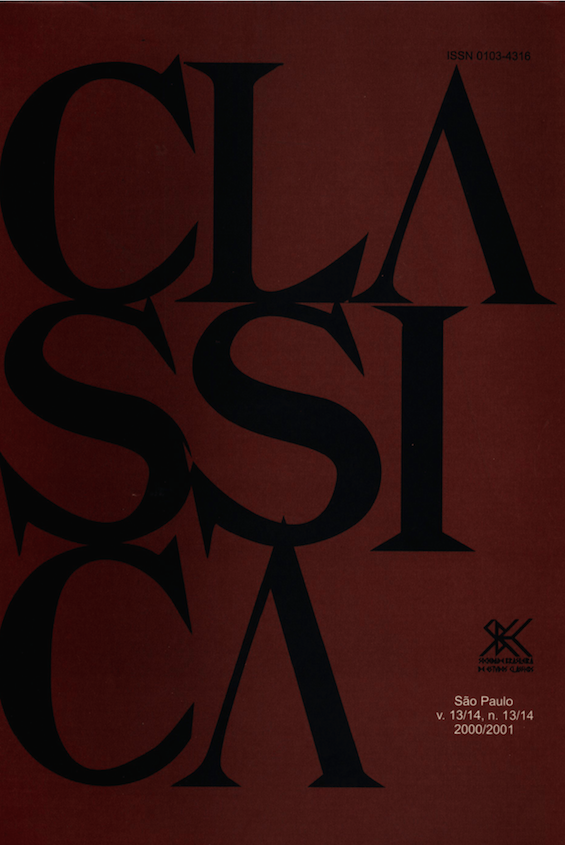Os monumentos de Atenas na Lisístrata de Aristófanes
DOI:
https://doi.org/10.24277/classica.v13i13/14.482Palavras-chave:
Comédia grega, Aristófanes, Lisístrata, ágora ateniense, arte grega, tradição iconográfica.Resumo
Na Lisístrata de Aristofanes, os monumentos de Atenas desempenham um papel importante para o desenvolvimento da trama cômica. Em maior evidência, a Acrópole, ocupada pelas mulheres, e parte essencial do plano da heroína para por fim a guerra fratricida entre espartanos e atenienses. 0s homens, por sua vez, excluídos da cidade alta, fincam o pé na Ágora, tomando por símbolos de sua resistência o grupo escultórico dos tiranicidas e a amazonomaquia de Mícon. Pretende-se aqui investigar as razões que levaram o semicoro masculino a escolher justamente esses monumentos para ilustrar sua fala.
Downloads
Referências
AMERICAN SCHOOL OF CLASSICAL STUDIES AT ATHENS. Petit guide de l'agora d'Athènes. Album n. 16 des fouilles de l'agora d'Athènes. Athens: American School of Classical Studies at Athens, 1986.
ARISTOPHANES. Lysistrata. Edited with introduction and commentary by J. Henderson. Oxford: Clarendon Press, 1990.
ARISTÓTELES. A constituição de Atenas. Edição bilíngüe com tradução e comentários de Francisco Murari Pires. São Paulo: HUCITEC, 1995.
ARRIAN. Anabasis Alexandri. Edited and translated by Ilif Robson. Cambridge/ Massachusetts: Havard University Press, 1956.
BARRON, J. New light on old walls. The murals of the Theseion. Journal of Hellenic Studies, 92, p. 20-45, 1972.
BOARDMAN, J. L' art grec. Paris: Flammarion, 1966.
BOWIE, A. Aristophanes: myth, ritual and comedy. Cambridge: Cambridge University Press, 1993.
CALAME, C. Thésée et l'imaginaire athénien. Légende et culte en Grèce antique. Lausanne: Éditions Payot Lausanne, 1990.
DAVIE, J. N. Theseus the king in fifth-century Athens. Greece & Rome, 29, p. 25-33, 1982.
FRANCIS, E. D. Image and idea in fifth-century Greece. Art and literature after the Persians Wars. London: Routledge, 1990.
HENDERSON, J. Lysistrata: the play and its themes. In:_______ . (Org.) Aristophanes: Essays in interpretation, Cambridge: Cambridge University Press, 1980, p. 153-218.
HENDERSON, J. The maculate muse. Obscene language in Attic comedy. New York/ Oxford: Oxford University Press, 1991 (1975).
HERODOTE. Histoires. Texte établi et traduit par Ph.-E. Legrand. Paris: Les Belles Lettres, 1970.
HUBBARD, T. The mask of comedy: Aristophanes and the intertextual parabasis. Cornell Studies in Classical Philology, 51, 1991.
HULTON, O. The women on the Acropolis: a note on the structure of the Lysistrata. Greece & Rome, 19, p. 32-36, 1972.
LORAUX, N. L'acropole comique. In:________ . Les enfants d'Athéna. ldées athéniennes sur la citoyenneté et la division des sexes. Paris: Editions de la Découverte, 1984, p. 157-196.
PAUSANIAS. Description de la Grèce. Livre I: L' Attique. Texte établi par Michel Casevitz, traduit par Jean Pouilloux et commenté par François Chamoux. Paris: Les Belles-Lettres, 1992.
POLLITT, J. J. The art of ancient Greece. Source and documents. London: Cambridge University Press, 1990 (1965).
PLUTARQUE. Cimon. In:________. Vies VII. Texte établi et traduit par Robert Flacelière et Émile Chambry. Paris: Les Belles Lettres, 1972.
RICHTER, G. The sculpture and sculptors of the Greeks. New Heaven, 1970.
ROBERTSON, M. A history of Greek art. London: Cambridge University Press, 1975.
RUSSO, C. Aristophanes an author for the stage. Tradução de Kevin Wren. Routledge: London and New York, 1994.
SMITH, C. Kylix with exploits of Theseus. Joumal of Hellenic Studies, 2, p. 57-64, 1881.
THOMPSON, H. A. The sculptural adornment of the Hephaisteion. American Joumal of Archaeology, 66, p. 339-347, 1962.
THUCYDIDE. La guerre du Péloponese. Texte établi et traduit par Jacqueline de Romilly. Paris: Les Belles Lettres, 1968.
WOODFORD, S. More light on old walls: the Theseus of the centauromachy in the Theseion. Joumal of Hellenic Studies, 94, p. 158-165, 1974.
WYCHERLEY, R. E. The temple of Hephaistos. Joumal of Hellenic Studies, 79, p. 153-163, 1959.
WYCHERLEY, R. E. Two notes on Athenian topography. Joumal of Hellenic Studies, 95, p. 117-121, 1975.
Downloads
Publicado
Edição
Seção
Licença
Autores que publicam nesta revista concordam com os seguintes termos:
a. Autores mantém os direitos autorais e concedem à revista o direito de primeira publicação, com o trabalho simultaneamente licenciado sob a Creative Commons Atribuição 4.0 Internacional (CC BY 4.0) que permite o compartilhamento do trabalho com reconhecimento da autoria e publicação inicial nesta revista.
b. Autores têm autorização para assumir contratos adicionais separadamente, para distribuição não-exclusiva da versão do trabalho publicada nesta revista (ex.: publicar em repositório institucional ou como capítulo de livro), com reconhecimento de autoria e publicação inicial nesta revista.
c. Autores têm permissão e são estimulados a publicar e distribuir seu trabalho online após o processo editorial (ex.: em repositórios institucionais ou na sua página pessoal), já que isso pode gerar alterações produtivas, bem como aumentar o impacto e a citação do trabalho publicado (Veja O Efeito do Acesso Livre).
d. Autores autorizam a cessão, após a publicação, de seu conteúdo para reprodução em indexadores de conteúdo, bibliotecas virtuais, bases de dados de acesso público e similares.











